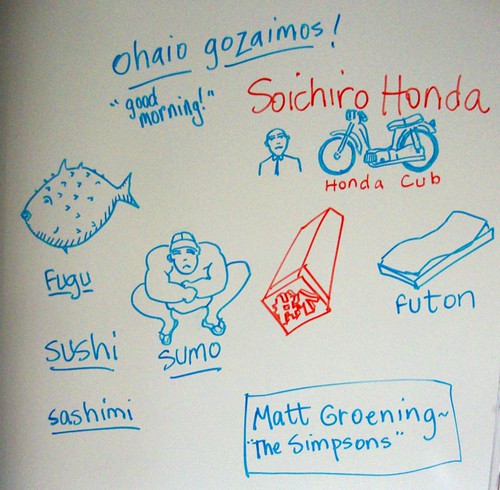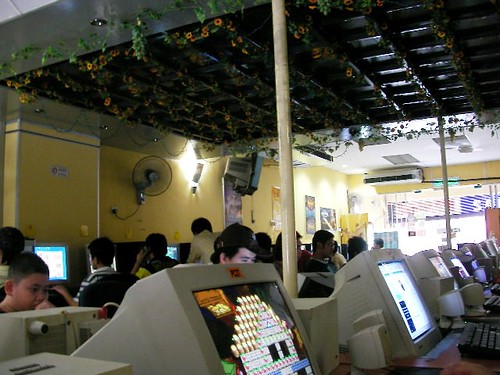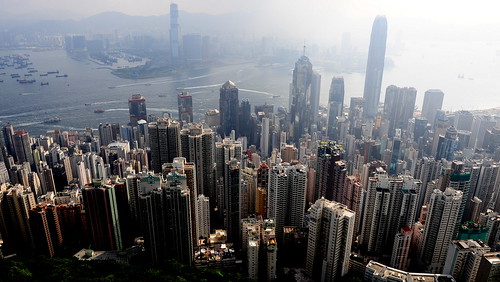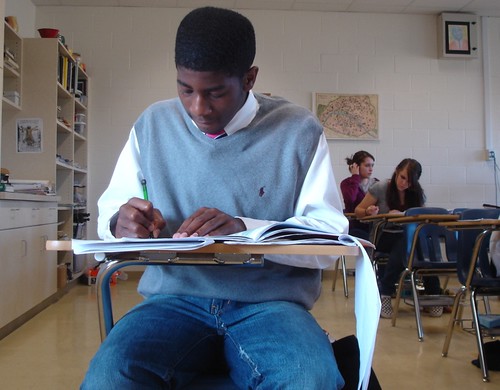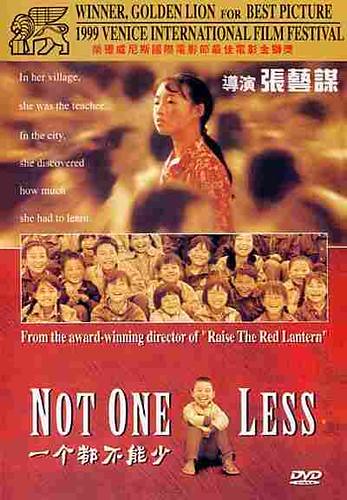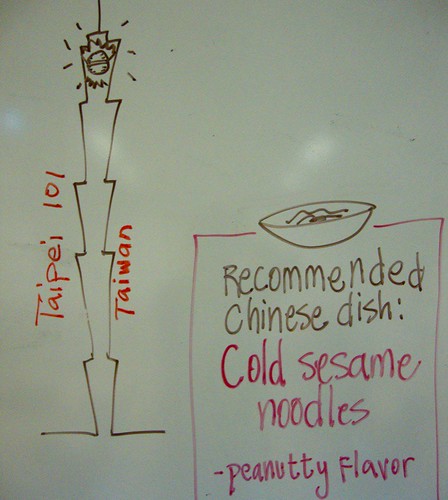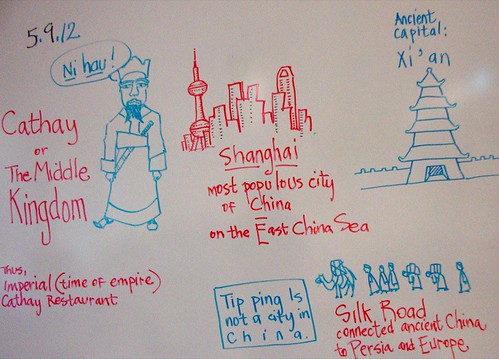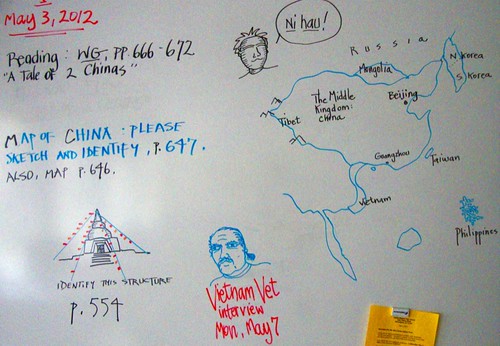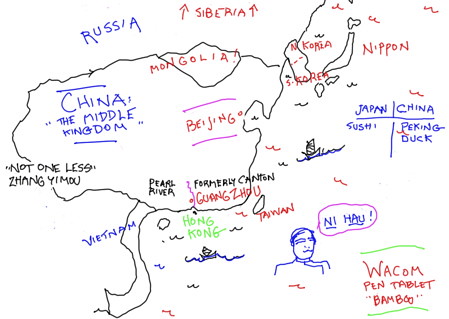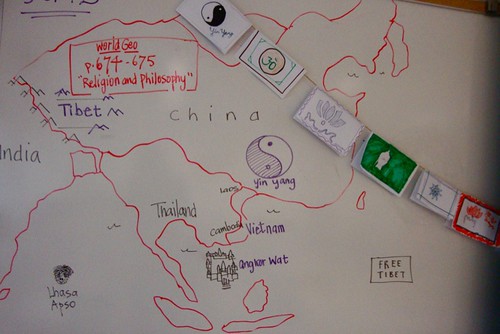The Freshman Talent Show produced by the Class of 2016 will be performed on Fri, Jan 11, 6:30 pm, says Robert Trudeau, class sponsor.
Try-outs will be after school in the PAC on Dec 18 - 20.
A week of rehearsals leading to the production will take place in the PAC after school Jan 7 to the 11.
Tuesday, May 29, 2012
Freshman Talent Show, Class of 2016, on Fri, Jan 11
Wednesday, May 23, 2012
Final exam mandatory comparison essay, 20 pts.
Choose any 2 topics from this semester in your notes or the blog.
Examples:
- Qin Shih Huang Di and Siddhartha Gautama
- The Chinese Chow chow and Dromedary of the Arabian peninsula
- The movies "Not One Less" and "Lost Boys of Sudan"
- Mohandas K Gandhi and TE Lawrence
- Integrate, or blend, the topics. Do not write separate paragraphs and a summary on the two topics.
- Facts and details are the key to your points. Include events, dates, locations, descriptions.
- Documentation via "according to."
- Include comparison terms such as "but," "in addition to," "however," "therefore," etc.
- Jazzy title and colorful opening sentence.
For guidelines on the 50 open notes, multiple answer questions, scroll on.
Caddo Magnet HS students @ Valencia Communty Garden: "Our peanut plants"
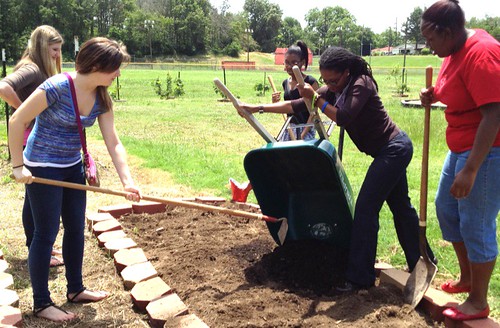
Caddo Magnet HS students / Valencia Communty Garden / photo Keri Stevenson, a photo by trudeau on Flickr.
Ji’Keeriya Bowden / Our Peanut Plants
Planting peanuts was very challenging.
There were a lot of things we had to do before we could put the peanuts plants into
the ground. First, we had to get the soil ready for planting.
To dig up the soil and get it ready for planting, Haylee, Zaria, Olivia,
and I needed some tools first. We found one of the janitors and asked him if we could borrow some shovels. After he happily gave
us some shovels and a hoe, we started our journey to Valencia Park.
Once we made it to Valencia Park, we met Mrs. Shalon Lewis, manager of the Valencia Community Center. She was very nice and very helpful. She gave us a wheelbarrow and instructions on how to get the soil ready correctly. Mrs. Lewis also helped us set up the bricks around our plot in the garden.
After we were done putting the bricks around the edge of our plot, she said goodbye and went back to the community center.
We had one more task to do that day and that was to get the weeds out of the soil in our plot. We used shovels and rakes to get the weeds out. Since we aren’t that strong and the shovels and rakes were pretty heavy, took us a while to finish.
About a week later, Haylee bought a peanut plant and some peanut seeds. We could finally start planting our peanuts. The soil needed a little tending to since it was a while since we were down there.
Mrs. Lewis told us that we needed to put some compost in the soil. While Haylee and Olivia were getting the soil ready, Zaria and I got a wheelbarrow and put some compost in it. We dumped the compost in our plot and mixed it in. Mixing the compost into the soil was pretty easy.
After mixing the compost in, it was time to plant our peanut plants and peanut seeds. The holes where the peanuts go had to be two inches deep. Putting the peanut plant and seeds into the soil wasn’t hard, and when we were done I patted then soil down
around the plants.
“Planting peanuts will be easy!” Planting them was really fun, but it was far from easy.
Monday, May 21, 2012
Demographics: Japanese girls just want to have fun
Japan experienced net population loss in recent years due to falling birth rates and almost no net immigration, despite having one of the highest life expectancies in the world at 81.25 years of age as of 2006, says Wikipedia.[2]
Based on the Health and Welfare ministry estimation released in January 2012, Japan's population will keep declining by about one million people every year in the coming decades, which will leave Japan with a population of 87 million in 2060. Current pop. is 128 million. By that time, more than 40% of the population is expected to be over the age of 65.[4]
According to a government survey, more than a quarter of unmarried men and women between the ages of 30 and 34 are virgins. 50% of men and women in Japan said they were not “going out with anybody”.[41]
Metropolitan Tokyo-Yokohama, with 35,000,000 people, is the world's most populous city.
Japan faces the same problems that confront urban industrialized societies throughout the world: over-crowded cities and congested highways.
Nihon / Japan: Soichiro Honda
Soichiro Honda (1906 – 1991) was a Japanese engineer and industrialist, and founder of Honda Motor Co., Ltd..[1]
Honda was born in Hamamatsu, Shizuoka, Japan, says Wikipedia, in 1906. He spent his early childhood helping his father, Gihei, a blacksmith, with his bicycle repair business. At the time his mother, Mika, was a weaver.
At 15, without any formal education, Honda left home and headed to Tokyo to look for work. He obtained an apprenticeship at a garage in 1922, and after some hesitation over his employment, he stayed for six years, working as a car mechanic before returning home to start his own auto repair business in 1928 at the age of 22.
In 1937 Honda founded Tōkai Seiki to produce piston rings for Toyota. During World War II US B-29 bomber attack destroyed Tōkai Seiki's Yamashita plant in 1944, and the Itawa plant collapsed in the 1945 Mikawa earthquake, and Soichiro Honda sold the salvageable remains the company to Toyota after the war and used the proceeds to found the Honda Technical Research Institute in October 1946.[2][3]
In 1948 he started producing complete motorcycles as president of the Honda Motor Company. Honda turned the company into a billion-dollar multinational that produced the best-selling motorcycles in the world.
Honda's engineering and marketing skills resulted in Honda motorcycles' outselling Triumph and Harley-Davidson in their respective home markets. In 1959 Honda Motorcycles opened its first dealership in the United States.
His status was such that People magazine placed him on their "25 Most Intriguing People of the Year" list for 1980, dubbing him "the Japanese Henry Ford." In retirement Honda busied himself with work connected with the Honda Foundation.
The Honda Cub is a scooter-like motorcycle with a four stroke single cylinder engine ranging in displacement from 49 to 109 cc.
Having been in continuous manufacture since 1958, with production surpassing 60 million in 2008,[1][2] the Super Cub is the most produced motor vehicle* in history.[3][4]
The Super Cub's US advertising campaign, "You meet the nicest people on a Honda", had a lasting impact on Honda's image and on American attitudes about motorcycling, and is considered a classic case study in marketing.
Friday, May 18, 2012
First Emperor Qin Shi Huang Di and the Terra Cotta Army at Xi'an
The Terra Cotta Warriors and Horses is a collection of sculptures depicting the armies of Qin Shi Huang, the first Emperor of China, says Wikipedia.
It is art buried with the emperor in 210–209 BC and whose purpose was to protect the emperor in his afterlife, and to make sure that he had people to rule over.
The figures, dating from 3rd century BC, were discovered in 1974 by some local farmers in Lintong District, Xi'an, Shaanxi province, near the Mausoleum of the First Qin Emperor.
The figures vary in height according to their roles, with the tallest being the generals. The figures include warriors, chariots and horses.
Current estimates are that in the three pits containing the Terracotta Army there were over 8,000 soldiers, 130 chariots with 520 horses and 150 cavalry horses, the majority of which are still buried in the pits.[1] Other terracotta non-military figures were also found in other pits and they include officials, acrobats, strongmen and musicians.
Please see an overview video:
http://www.youtube.com/watch?v=RsUE-ZtcUFg
Weapons such as swords, spears, battle-axe, scimitars, shields, crossbows and arrowheads were found at the pits of the terracotta warriors.[21][29] Some of these weapons such as the swords are still very sharp and found to be coated with chromium oxide. This layer of chromium oxide is 10–15 micrometre thick and has kept the swords rust-free and in pristine condition after 2,000 years.[30][31][32] Chromium only came to the attention of westerners in the 18th century.[33] Many swords contain an alloy of copper, tin and other elements including nickel, magnesium, and cobalt.[34] A Qin crossbow arrow is estimated to have a range of 800 metres.
Chinese guard dogs & male-dominant gender imbalance
Chow Chow is a breed of dog that was developed in China,[1] where it is referred to as Songshi Quan or "puffy-lion dog".
The breed has a very dense double coat, says Wikipedia, that can be either smooth or rough. The fur is particularly thick around the neck, giving the distinctive ruff or mane appearance.
Recent DNA analysis confirms that the Chow Chow is one of the oldest breeds of dog.
More than 24 million Chinese men of marrying age could find themselves without spouses by 2020, says the Chinese Academy of Social Sciences.
The gender imbalance among newborns is the most serious demographic problem for the country's population of 1.3 billion, says the academy.
It cites sex-specific abortions as a major factor, due to China's traditional bias towards male children.
Academy sociologist Yan Hua said: "People's minds have changed a lot during the last 20 years.
"Young couples either don't want to have a second child, or would prefer to live a DINK (Double Income No Kid) life."
The academy says gender selection abortions are "extremely common".
This is especially true in rural areas, and ultra-sound scans, first introduced in the late 1980s, have increased the practice.
The growing imbalance means that forced prostitution and human trafficking has become "rampant" in some parts of the country, according to the researchers.
While analysts admit there is definitely a pronounced gender imbalance in China, they also say that exact information is difficult to obtain because some families are thought to avoid registering female babies in order to make it easier for them to have a second child.
Wednesday, May 16, 2012
Second semester world geography study guide, 2012
Open notes, 50 multiple-choice questions, one comparison essay. Be aware that numerous questions will have been tweaked - answers switched, wording re-arranged - so that you can have a mindful review.
1. New Orleans African heritage: a) West b) East c) North
2. translate: bons a) Let b) the c) good d) times e) roll
3. translate: rouler a) Let b) the c) good d) times e) roll
4. translate: laissez a) Let b) the c) good d) times e) roll
5. translate: temps a) Let b) the c) good d) times e) roll
6. translate: gras a) Let b) the c) good d) fat
7. Louisiana's carnival season does not begin on a) Twelfth Night b) Epiphany c) Jan 6 d) Ash Wed.
8. Dionysian celebration: a) Greek b) Roman c) Persian.
9. Lupercalia: a) Greek b) Roman c) Persian.
10. Translate Carne: ___ and vale: ___ a) Goodbye to fun b) goodbye to dancing c) goodbye to meat.
11. Translate: "Lent." a) springtime b) fasting c) abstinence d) Carnival.
12. First nation associated with carnival. a) Italy b) France c) Germany.
13. First historic era in which Carnevale is written about: a) Medieval b) Renaissance c) Elizabethan.
14. Riotous, scandalous behavior was integral to the European history of Carnival. T / F
15. Shrove Tuesday a) pancake day b) non-Catholic Carnival c) forgiveness of sins.
16. Endymion: a) female b) male c) Hispanic d) African-American krewe in New Orleans.
17. Why were parades instututed in New Orleans about 1857? a) make money and quiet the riotous behaviour b) favored by the Catholic Church.
18. European city that establishes the early carnival customs. a) Paris b) Munich c) London d) Venice.
King Cake Quiz
1. Louisiana's carnival season does not begin on a) Twelfth Night b) Epiphany c) Jan 6 d) Ash Wed.
12. How long did French immigrants live in Nova Scotia before being expelled from the region they called Acadia and going on a journey that would take them to Louisiana? a) 50 b) 100 c) 200.
13. A French name for a community dance or a Cajun house party? a) a bon plaisir b) Laissez les bons temps rouler c) Fais do-do d) Mais, oui!
aceadddabcaaaTcaaddbc
From Oxfordshire to Mecca / Lawrence of Arabia quiz
1. On his journey from London to Cairo, Lawrence's ship went through the Atlantic and the Mediterranean. His boat also had to traverse the a) English Channel
b) Suez Canal c) Red Sea d) Persian Gulf.
2. In Cairo the viewer sees Lt. Lawrence at his British Army work: a) demolitions
b) dossier c) cartography d) translating Arabic.
3. Lt. L. is sent to Saudi Arabia to observe the progress of the __ . a) Turks
b) Bedouins c) Persians d) camels.
4. The "Med" is not spelled a) Mediterranean
b) Mediterranean c) Mediterranean d) Mediterannean.
5. If your ship travels south from Cairo on the Red Sea your destination might be a) Greece b) Palestine c) Ethiopia d) Lebanon.
6. Body of water on the eastern side of the Arabian peninsula: a) Persian Gulf b) Indian Ocean c) Red Sea d) Nile R..
7. The capture of Damascus is the ultimate goal of the Bedouin forces.
Damascus is the capital of __. a) Syria b) Lebanon c) Iraq.
8. The south coast of the Arabian peninsula is part of a trade route connecting
a) India and East Africa b) Egypt and Europe c) Persia and China d) East Africa and West Africa.
9. Egypt's bordering nation on the northeast is a) Yemen b) Oman c) Israel
d) Lebanon.
10. Lawrence became expert at the __ camel. a) Bactrian b) Dromedary c) Persian d) Qu'ranic.
11. Lawrence leads Bedouin forces against the Turks from 1915 to 1918, says Wikipedia. This implies a) love of war b) consistent leadership
c) ethnocentrism d) enormous egotism.
12. Col. Brighton asserts that "Britain is a small country. What makes it great is __ . " a) discipline b) navy c) technology d) bravery.
acbdcaaacbba
Prince Feisal quiz
1) In Arabia there is a conflict between the nomadic, tribal Bedouin peoples and the Turks, rulers of the Turkish Ottoman Empire - which includes Arabia. Who’s on the German side? a) Bedouins b) Turks.
2) “The Officer’s Mess” is a term for
a) a carelessly kept meeting room or b) the lounge area for the commissioned soldiers.
3) Arabian tribes are led by the wise, if weary,
a) Prince Feisal of Mecca b) Lloyd George c) Woodrow Wilson.
4) What is the attitude of L’s desert guide toward the British officer’s pistol carried by L.? a) curiosity b) extreme desire c) unconcern.
5) The Arabic word for canyon, usually a dry, rocky area between mesas, is “wadi.” What do the existence of these stone canyons say about the ancient geography of this region? a) centuries of wind erosion b) ancient waterways c) glaciation.
6) The tribal groups of the Harish versus the Hazimi: we conclude that murderous tribal warfare is a historic part of life in the vast desert. T / F
7 ) What kind of vessel is used to bring up water from the deep well in the desert? a) Goat skin b) wooden bucket c) woven-palm sort of basket-bucket.
bbabbta.
Wadi quiz
1) When the troops leave the wadi, the women watching them emit a high-pitched scream as encouragement. What is that called? a. ovulation b. ululation c. trepidation d. insubordination.
2) What small, Turkish-held city will be attacked by the combined tribes of the Harish and the Hazimi in a surprise raid?
a) Cairo b) Medina c) Aqaba.
3) This Turk-controlled city lies on what body of water? a) Gulf of Aqaba b) Gulf of Suez c) Gulf of Aden.
4) Lawrence is awarded the robes of a tribesman for his valorous service. Somehow, he finds the indigenous garments a) uncomfortable b) appealing c) murderous.
5) In the desert the Bedouins find a place surrounded by trees where their camels can drink. It is called an __ . a) aquifer b) fountain c) oasis.
6) What kind of trees are those - which thrive in the middle of the desert? a) coconut palms b) date palms c) oasis palms .
7) Days of WWI: From 1914 to __ . a) !917 b) 1918 c) 1920.
bcabcbb
Blasphemy quiz
1) Translate "Peace (be with you)” into Arabic: a) shalom b) salaam c) shazam.
2) Re. the scene where the Bedouins are strafed and have to move their camp. Where did the Turks get airplanes in 1916? a) Germans b) French c) British.
3) The scene is Feisal's tent. “Recite, then, as much of the __ as may be easy for you ... and seek ye the forgiveness of God. Verily, God is forgiving, merciful ...” These are the opening words of the a) Qu’ran b) Bible c) Baghavad Gita .
4) The scene in Feisel’s tent is unusually respectful of Muslims. I say “unusually” because of the traditional attitude: a) Western world's lack of respect for Muslims b) low Muslim self-concept c) all they have is oil, fine Persian rugs and chewy date fruit.
5) Lawrence quotes the Qu'ran. How would he know such material?
a) movie producer explained it to him b) his momma c) his Oxford education.
6) In 1915 the top British priority in the Mid East was protection of a waterway important to their shipping and movement of warships. What is the name of this key passage, which connects the Mediterranean to the Indian Ocean? a) Arabian Sea b) Panama Canal c) Suez Canal.
7) In explaining to Feisel the reason for Britain’s worldwide power, the British officer puts an emphasis on England's __ . a) technology b) discipline c) skill d) wealth.
8) In the early 1900’s the city at the center of Islamic art, business and scholarship was not Mecca, nor Cairo. It was: a) Medina b) Damascus c) Jerusalem .
9) According to Feisel, do Arabs love the desert? No. Then what do they love? a) fountains and gardens b) mountains c) ships and oysters.
10) At the desert’s edge Lawrence spends a night concentrating on the Arab dilemma in their feckless fight against the Turks. He has a breakthrough. What is his solution? a) attack from the sea b) attack at night c) attack from the desert.
11) A cruel and terrible desert must be crossed by the Bedouin.
The desert is the a. Sahara b. Rub al Kali c. Nefud.
baaaccbbacc
East of the Mediterranean
1. Nation that is Not on the shores of the Med: a) Syria b) Turkey c) Jordan d) Israel.
2. North of Jordan: a) Syria b) Iraq c) Palestine d) Egypt.
3. Nation that is Not on the Persian Gulf: a) Kuwait b) Saudi Arabia c) Yemen d) Oman.
4. Nation that is Not on the Arabian Peninsula: a) Egypt b) Jordan c) Oman d) UAE.
5. Body of water most closely associated with the Arabian peninsula: a) Mediterranean b) Atlantic c) Indian Ocean d) Black Sea.
6. Island nation on Persian Gulf: a) Bahrain b) Qatar c) UAE d) Kuwait.
7. The sole non-Muslim nation of the Middle East: a) Egypt b) Israel c) Lebanon d) Syria.
8. The Persian Gulf is named for a) Iran b) Iraq c) Saudi Arabia d) Oman.
9. The nation of Israel is believed to have nuclear bomb capability. The next nation of the Mid East to achieve nuclear status will be: a) Iran b) Iraq c) Saudi Arabia d) Oman.
cacacabaa
Ancient crossroads: Jerusalem
1. Jerusalem happens to be located, if you check on this carefully, in the nation of a) Jordan b) Israel c) Egypt d) Syria.
2. "The street of sorrows," is better known as a) Via Dolorosa b) Church of the Holy Sepulchre c) Christian Quarter d) Arab Quarter.
3. About 300 AD (CE) a person arrived from Constantinople to ask where Jesus of Nazareth had been crucified and buried. That person was a) Constantine, the Roman Emperor b) Herod, the Jewish leader who was an ally of the Romans c) Nebuchadnezzar of Persia
d) Helena, mother of Constantine.
4. Who was the most ancient historic figure? a) Abraham b) Jesus of Nazareth c) the Prophet Muhammed.
5. Ehich one is the most recent historic figure? a) Abraham b) Jesus of Nazareth c) the Prophet Muhammed.
6. Which one of these men is revered by adherents in 3 religions? a) Abraham b) Jesus of Nazareth c) the Prophet Muhammed.
7. In the center of the city of Mecca is a shrine called the a) Black Stone b) Kaaba c) Grand Mosque d) Minaret.
8 and 9. There are 2 sites on the Temple Mount, the highest elevation in Jerusalem. Choose 2: a) Church of the Holy Sepulchre b) Dome of the Rock c) Western Wall of the Jewish Temple d) Via Dolorosa e) Armenian Quarter.
10. Holy to the memory of both Abraham and the Prophet Muhammed: a) Dome of the Rock b) Western Wall of the Ancient Temple
c) Church of the Holy Sepulchre d) Via Dolorosa.
11. The word sepulchre means a) mound b) room c) rock d) tomb.
12. In Shakespeare's play The Merchant of Venice the money lender is a) Shylock, the Jew b) Antonio, the wealthy Venetian c) Jessica, the Jew's daughter d) The Prince of Verona.
13. The 3500-mile fissure called the Great Rift Valley cuts through __ Africa. a) East b) West c) South d) North.
badacabb-cadaa
1. Name the nation - from class notes - that is located farthest from the island of Zanzibar on the continent of Africa, continent of Africa. a) Morocco b) Nigeria c) Tanzania d) South Africa.
2. Name the type of ship used in connecting India and Africa: the ___ . a) Arabian b) dhow c) safari d) sloop.
3. Historic trade goods in this region of the world: ivory, spices and __. a) copper b) coral c) slaves d) petroleum.
4. Typical of valuable modern trade goods exported from the east coast of Africa: __ a) minerals b) textiles c) steel d) fish.
5. Geographers divide the continent of Africa, continent of Africa, into the region north and south of the immense arid region called the __ . a) Sahara b) Kalahari c) Great Rift Valley d) Horn of Africa.
6. Rafiki is a Swahili word for " __ ". a) lion b) monkey c) hello! d) friend.
7. A nation that is part of the 3500 mile Great Rift Valley: __ . a) Nigeria b) Ethiopia c) Egypt d) Morocco.
8. Wealthiest nation on the continent of Africa, content of Africa:
____ . a) South Africa b) Nigeria c) Egypt d) Kenya.
9. Nation that is located at the lowest part - at the mouth - of the Nile River: __ . a) Egypt b) Uganda c) Ethiopia d) Sudan.
abcaadbaa
Kilimanjaro Quiz
1. In which nation is the great mountain called Kilimanjaro? a) Uganda b) Kenya
c) Tanzania d) Zanzibar
2. All these locations - a) Uganda b) Kenya c) Tanzania d) Zanzibar - happen to be part of the Great Rift Valley. T / F
3. Most people in these nations - Uganda, Kenya, Tanzania - speak Swahili, English and a tribal language. T / F
4. Which one of these nations would Not show much influence from the Arabia and India? a) Uganda b) Kenya c) Tanzania d) Zanzibar.
5. Seaweed, octopus, lobsters and coral would be most common in which location? a) Uganda b) Kenya
c) Tanzania d) Zanzibar.
6. The warlord Joseph Kony is associated with which nation? a) Uganda b) Kenya
c) Tanzania d) Zanzibar.
7. Which of these nations is thought of as the source of the Nile? a) Uganda b) Kenya
c) Tanzania d) Zanzibar
8. "The Leopards of Zanzibar" is a story from the island of Zanzibar and the nation of __ . a) Uganda b) Kenya c) Tanzania d) Zanzibar
9. The city of Nairobi is the NYC of East Africa. It is the capital of a) Uganda b) Kenya
c) Tanzania d) Zanzibar
cftadaacb
The African genocide quiz
1. Region of Sudan that was the home of the Dinka. a) South b) North c) Lake Victoria d) Uganda.
2. Two great rivers converge and become one northward flowing river in this nation: a) Sudan b) Ethiopia c) Egypt d) Uganda.
3. The Dinka people were slaughtered by the a) Arab Sudanese b) Christian Sudanese c) Tribal Sudanese.
4. Thousands of the males of the Dinka tribe were sold into slavery. T / F
5. The Blue Nile originates in a) Sudan b) Ethiopia c) Egypt
d) Uganda.
6. The White Nile originates in a) Sudan b) Ethiopia c) Egypt
d) Uganda.
7. The tree that is characteristic of the East African landscape: a) Baobab b) African Pine c) Acacia d) Yam.
8. Capital city of Sudan: a) Addis Ababa b) Nairobi c) Khartoum
d) Dar es Salaam.
aaafbdcc
Gandhi in Delhi
1. Traditional sweet scent of India packaged as a garland: a) gardenia b) rose c) lilies d) jasmine.
2. South Africans have numerous derogatory terms for Indians. Not among them: a) Sammy b) coolie c) kaffir d) pachuco.
3. On the train in South Africa Gandhi quotes a book of __ literature. a) Christian b) Hindu c) Muslim d) Sikh.
4. Gandhi uses the phrase "children of __ " to emphasize the incorrectness of racist laws. a) Brahma b) Allah c) God.
5. Car manufacturing company that produces a cheap city car: a) Nano b) Tata c) Momo d) Bapu.
6. Nefarious crop emphasized by the British in India - to be sold to the Chinese. a) indigo b) tobacco c) saffron d) opium.
7. City on the Bay of Bengal: a) Delhi b) Agra c) Mumbai d) Kolkata.
8. City on the Arabian Sea: a) Delhi b) Agra c) Mumbai d) Kolkata.
9. City called the Silicon Valley of India: a) Delhi b) Agra c) Mumbai d) Bangalore.
ddacbddcd
Gandhi in South Africa
1. Gandhi's life spanned the 19th and 20th centuries. T / F
2. Gandhi studied to be a barrister, which is a Britishism for: a) lawyer b) professor c) business man d) clergyman.
3. South Africa was a European colony at the turn of the century. It is part of the empire built by the a) British b) French c) Hindus d) Muslims.
4. In all his pronouncements, Gandhi encourages ethnic unity. That would be between the a) castes b) major social organizations c) armies d) governments.
5. Gandhi declares that being raised in a crossroads region gave him an unusual perspective on religion. He lived near a) Delhi b) Bay of Bengal c) Himalayas d) Arabian Sea.
6. What is the great social taboo of India that Gandhi wanted to change?
a) Hindu vs. Muslim b) the caste system c) the class system d) British vs. Indians.
7. Gandhi felt that the beliefs of Christianity might help people understand racism. T / F
8. Gandhi understood poverty and accepted it as inevitable in India.
T / F
9. Gandhi was not assasinated; he was assassinated. T / F
1.t 2.a 3.a 4.a 5.d 6.b 7.t 8.t
1. The Taj Mahal was built about the year __ .
2. Its construction was commanded by the emperor called the __ Jahan.
3. Jahan was the Mughal - or Mogul - emperor of ___ India.
a) northern b) eastern c) southern d) western.
4. The design of the Taj reflects a particular religion: a) Islam b) Judaism c) Hinduism d) Jainism.
5. It was built of white __ (type of stone) for Mumtaz Mahal.
6. A building that is a tomb is called a __. a) masala b) malformed c) mausoleum d) mandible.
7. The designers of the Taj were from the nation of __ . a) Persia b) Afghanistan c) Arabia.
8. There are three items of the Taj Mahal complex that identify the Shah's culture as Islamic: the mosque, the Arabic inscriptions and the towers called __ .
9. The decorative designs on the walls are called __.
10. Aside from the decorated caskets of the emperor and his wife, the interior of the Taj Mahal is empty. T / F
11. In the final chapter of his life the emperor's son, Aurangzeb, made sure his father was __.
1.1600
2.shah
3.a
4.a
5.marble
6.c
7.a
8.minarets
9. arabesques or calligraphy
10. t
11. imprisoned
Tuesday, May 15, 2012
Cybercafes: "Chinese govt blocks website content and monitors the internet access of individuals"
More than sixty Internet regulations made by the People's Republic of China (PRC) government block the nation's access to open news and communications, says Wikipedia.[1][2]
The apparatus of the PRC's Internet repression is considered more extensive and more advanced than in any other country in the world. The governmental authorities not only block website content but also monitor the Internet access of individuals.
Amnesty International notes that China “has the largest recorded number of imprisoned journalists and cyber-dissidents in the world.”
The offences of which they are accused include communicating with groups abroad, signing online petitions, and calling for reform and an end to corruption.
"One family, one child" policy effective against over population
The One Child policy officially restricts married, urban couples to having only one child, says Wikipedia, while allowing exemptions for several cases, including rural couples, ethnic minorities, and parents without any siblings themselves.[2]
A spokesperson of the Committee on the One-Child Policy has said that approximately 35.9% of China's population is currently subject to the one-child restriction.
This policy, introduced in 1979, was created by the Chinese government to alleviate social, economic, and environmental problems in China.
Authorities claim that the policy has prevented between 250 and 300 million births from its implementation until 2000,[2] and 400 million births from 1979 to 2011.[5]
The policy is controversial both within and outside China because of the manner in which the policy has been implemented, and because of concerns about negative social consequences.
Monday, May 14, 2012
Know your Basic Mandarin!
Need a refresher?
Please see http://www.youtube.com/watch?v=PMgeux646V0&feature=relmfu.
Hong Kong Island 香港:遥看九龙
As one of the world's leading international financial centres, Hong Kong has a major capitalist service economy characterised by low taxation and free trade, and the currency, Hong Kong dollar, is the eighth most traded currency in the world, says Wikipedia.[29]
The lack of space caused demand for denser constructions, which developed the city to a centre for modern architecture and the world's most vertical city.[30][31]
Hong Kong has one of the highest per capita income in the world.[6]
The dense space also led to a highly developed transportation network with public transport travelling rate exceeding 90 percent,[32] the highest in the world.[33]
Hong Kong has numerous high international rankings in various aspects. For instance, its economic freedom, financial and economic competitiveness, quality of life, corruption perception, Human Development Index, etc., are all ranked highly.
Sunday, May 13, 2012
Semester exam schedule, May 24 through 30
05/24- 1&3 hours
05/25- 5&7
05/28 Memorial day
05/29- 2&4
05/30- 6&8
World geography exam will comprise 100 multiple-choice questions from quizzes given this semester. Open notes. Additionally, students must compose a brief essay. A choice of topics will be listed.
Not One Less: a guide for social studies students
Not One Less, a story of China
1) Not One Less is a movie whose dialogue is in a) Mandarin Chinese b) Cantonese Chinese c) Rural Chinese.
In the following prompts choose between a. Teacher Gao b) the Mayor c) Teacher Wei d) Zhang Huike.
2) Most frugal character.
3) Directly battling the drop-out rate.
4) Money conscious.
5) Menial work.
6) Moderating, or balancing, influence.
7) Strongest in allegiance.
8) Stubborn.
9) Happy-go-lucky.
10) Philosophical and accepting.
11) Chinese currency: a) yuan b) yen c) Chinese dollar.
12) Shuixian School is located near a) Xi’an b) Beijing c) Shanghai.
13) Symbol of pride in learning and efficient use of resources in the school: a) sending swift runner of the class to the sports specialty school b) flag c) chalk.
14) Type of humor which crosses cultural borders: a) religious b) political c) scatalogical d) sarcasm.
15) The director of Not One Less: a) Jet Li b) Zhang Huike c) Zhang Yimou d) Shi Huang Di.
16) Substitute Wei is about age a) 10 b) 13 c) 16 d) 18.
17) Why do 5 students sleep in the schoolroom? a) they live too far away to walk to school each day b) saving their money for college c) paying off family debt by work at the school.
18) "Keeping kids in school is harder than teaching them." Quote from
a) the mayor b) Wei c) Teacher Gao.
19) The manager of the brick factory donates money to Wei and her class and says, "Call me a philanthropist." a) Person who sees the bad in life but tries to remain good. b) Person who is philosophical about life c) Person who gives generously to public causes.
The Odyssey of a Chinese teen in the movie Not One Less
1. The film addresses the ______ gap between urban and rural populations. a) language b) economic c) legislative d) population.
2. Given the following bureaucrats: the Mayor, the brick factory manager, the clerk at the TV station, the TV station manager and the restaurant manager, we should conclude that the movie's director sees bureaucrats as mostly negative forces. T / F
3. The film does Not address this issue: a) history of China b) poverty in China c) rural education d) difficulty of life in the cities.
4. Which one of these characters is not directly addressing the drop-out problem? a) Teacher Gao b) the Mayor c) Teacher Wei d) Zhang Huike.
5. Which one of these characters seems to provide a sense of balance and moderation? a) Teacher Gao b) the Mayor c) Teacher Wei d) Zhang Huike.
6. Which one of these characters is the most frugal? a) Teacher Gao b) the Mayor c) Teacher Wei d) Zhang Huike.
7. Which one of these characters shows heroic obstinacy? a) Teacher Gao b) the Mayor c) Teacher Wei d) Zhang Huike.
8. Shuixian School is located near the city of a) Hong Kong b) Xi’an c) Beijing d) Shanghai.
9. Is the mass media portrayed as a benign or a destructive force in China? The movie seems to say the news media is a) positive b) negative c) not a major factor.
10. A symbol of pride in learning and in the efficient use of resources in the school is: a) sending swift runner of the class to the sports specialty school b) flag c) chalk d) singing the anthem in an orderly formation.
11. "Keeping kids in school is harder than teaching them." Quote from a) the Mayor b) Substitute Wei c) Teacher Gao d) Zhang Huike.
12. Concerns about _____ dominate most of the characters and much of the film. a) ethics b) honor c) culture d) money.
Thursday, May 10, 2012
Taipei, Taiwan: a place of wealth and high-tech industry
Taiwan, a democracy, is known for its high standard of living. Thus it is one of the "Four Asian Tigers" alongside Hong Kong, South Korea and Singapore.
Recommended dish for a class taste of China -
Cold Sesame Noodles
Serves 4 as a main or 6 as an appetizer12 ounces dried spaghetti or Chinese egg noodles
2 tablespoons peanut oil
2 teaspoons minced garlic
2 teaspoons grated ginger
1 cucumber, peeled and julienned
2 carrot, peeled and julienned
2 teaspoons white sesame seeds
2 scallions, green parts only, thinly sliced
Sauce:
3 tablespoons Chinese sesame paste (or 3 tablespoons tahini with an extra teaspoon of sesame oil)
2 tablespoons smooth peanut butter
2 tablespoons soy sauce
1 tablespoon sesame oil
2 tablespoons Chinese rice vinegar
2 teaspoons chili paste
2 tablespoons sugar
½ teaspoon ground Sichuan pepper (optional)
See many Cold Sesame Noodle variations online.
Marco Polo's name: Cathay, and Qin Shi Huang's name: the Middle Kingdom
Three great cities to know:
Shanghai: at the mouth of the Yangtze, the world's most populous city. Some 23 million people. Fabulous harbor and skyline, including the Oriental Pearl Tower.
Beijing: Tianenmen Square and the Imperial City / Forbidden City.
Xi'an: the Wild Goose Pagoda and the Terra Cotta Army.
Summer reading list, Caddo Magnet HS, 2012
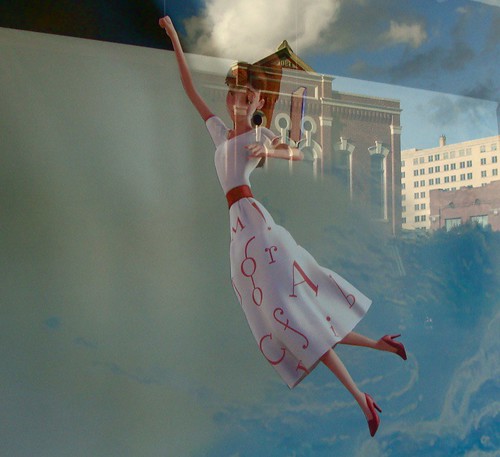
Sneak peek: The Fantastic Flying Books of Mr. Morris Lessmore at Artspace Shreveport, a photo by trudeau on Flickr.
English IEnglish I/GT
Acceleration - Graham McNamee Ender’s Game – Orson Scott Card
To Kill a Mockingbird - Harper Lee Fahrenheit 451 - Ray Bradbury
The Old Man and the Sea – Ernest Hemingway
English II English II/GT
A Raisin in the Sun - Lorraine Hansberry The Chosen – Chaim Potok
A Separate Peace - John Knowles Frankenstein – Mary Shelley
Samurai Shortstop – Alan Gratz The Good Earth - Pearl S. Buck
English III English III/GT
The Autobiography of Miss Jane Pittman – Earnest Gaines A Connecticut Yankee in King Arthur’s Court – Mark Twain
Farewell to Manzanar – Jeanne W. Houston & James D. Houston A Raisin in the Sun - Lorraine Hansberry
Short Story Masterpieces – Eds. Robert Penn Warren & Albert Erskine A Streetcar Named Desire – Tennessee Williams
English IV English IV/GT/AP
Brave New World – Aldous Huxley All the King’s Men – Robert Penn Warren
Lord of the Flies – William Golding
The Picture of Dorian Gray – Oscar Wilde The Stranger - Albert Camus
Also, choose one book from the following:
AP ONLY: A Prayer for Owen Meaney – John Irving The Kite Runner - Khaled Hosseini
The Swallows of Kabul – Yasmina Khadra
A Thousand Splendid Suns - Khaled Hosseini
Wednesday, May 09, 2012
Caddo Magnet HS students pilot peanut project in Valencia Communty Garden

Caddo Magnet HS students / Valencia Communty Garden / photo Keri Stevenson, a photo by trudeau on Flickr.
A pilot project in long-term social studies work has been begun by geography students. A group of 4 students - plus parents - are planting a peanut patch in the Valencia Community Garden.
While the peanuts cannot be harvested until the fall of 2012, the project is an important platform for research.
The peanut is a historic and high-protein crop, giving students insight into the past as well as the future. The concept of the modern community garden is another area of study.
In addition to parents, these students are being aided by Valencia Community Center and Garden manager Ms. Shalon Lewis.
Thursday, May 03, 2012
Mandarin Chinese: one billion speakers
"Ni hau!"
Mandarin dialects, particularly the Beijing dialect, form the basis of Standard Chinese, says Wikipedia.
Mandarin, as one language, has more native speakers (nearly a billion) than does any other language.
The English word "mandarin" (from Portuguese mandarim, from Malay [ˈməntəri] menteri, from Hindi mantri, from Sanskrit mantrin, meaning "minister or counsellor"), originally meant an official of the Chinese empire.
Cantonese, or Standard Cantonese, is a language that originated in the vicinity of Canton (i.e. Guangzhou) in southern China, and is often regarded as the prestige dialect of Yue Chinese.
The Cantonese language is also viewed as part of the cultural identity for the native speakers across large swathes of southern China, Hong Kong and Macau. Although Cantonese shares much vocabulary with Mandarin Chinese, the two languages are not mutually intelligible largely because of pronunciation and grammatical differences.
Indie work to add points . . .
Comparison essay / choose one -
- Gigantic India vs Minuscule Vietnam
- Timelines of the conflicts in Iraq and Vietnam
- Siddhartha Gautama and Ho Chi Minh
- The Bengal tiger and the Asian elephant
Jazzy title.
Integrated material.
Documentation.
Comparison phrases such as "but," "on the other hand," "like" etc
Specific facts: dates, locations, events, names, etc.
Tuesday, May 01, 2012
Tibet and China as well as Buddhist Prayer Flags
Tibet is a plateau region of China in Asia, north-east of the Himalayas, says Wikipedia.
Tibet is the highest region on earth, with an average elevation of 16,000 ft.
The region declared its independence from China in 1913. The region maintained its autonomy until 1951 when, following a military conflict, Tibet was incorporated into the People's Republic of China.
There are tensions regarding Tibet's political status[2] and dissident groups are active in exile.[3]
The economy of Tibet is dominated by subsistence agriculture, though tourism has become a growing industry in Tibet in recent decades. The dominant religion in Tibet is Tibetan Buddhism.
Tibetan Buddhism is a primary influence on the art, music, and festivals of the region.
Tibet has some of the world's tallest mountains, with several of them making the top ten list. Mount Everest, at 29,029 ft, is the highest mountain on earth, located on the border with Nepal.
Several major rivers have their source in the Tibetan Plateau. These include Yangtze, Yellow River, Indus River, Mekong and Ganges.
Tibet has been called the "Water Tower" of Asia, and China is investing heavily in water projects in Tibet.



